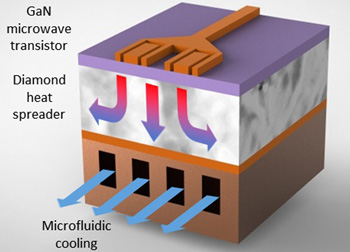- News
9 February 2017
UK's EPSRC awards University of Bristol £4.3m grant to develop GaN-on-diamond microwave technology
The University of Bristol has been awarded a £4.3m grant from the UK's Engineering and Physical Sciences Research Council (EPSRC) to lead a new project to develop gallium nitride (GaN)-on-diamond microwave technology.
The university notes that the next-generation technology is expected to underpin future high-power radio frequency and microwave communications, space and defence systems, paving the way for 5G and 6G mobile phone networks and much more comprehensive radar systems. Bristol will work with a consortium of four other universities (Cardiff, Glasgow, Cambridge and Birmingham) as well as industry partners during the five-year project.
"Global demand for high-power microwave electronic devices that can deliver power densities well exceeding current technology is increasing," says project leader professor Martin Kuball of Bristol's School of Physics. "In particular, GaN-based high-electron-mobility transistors (HEMTs) are a key enabling technology for high-efficiency military and civilian microwave systems, and increasingly for renewable energy plants," he adds.
Since data transmission in a mobile communication systems requires a certain amount of energy per bit, and in 5G the number of bits transmitted per second will be immense (and future systems will ask for even more), existing microwave devices that are used to transmit bits in 4G networks do not have the power needed.
The vision of the new project is to develop transformative GaN-on-diamond HEMTs and monolithic microwave integrated circuits (MMICs) as a technology step beyond existing microwave devices.
Energy flows in these can be as high as the heat flux on the surface of the sun, say the researchers, and diamond – due to its ultra-high thermal conductivity – is the only material that can handle them. The devices can allow the implementation of future communications networks and radar systems with capabilities beyond what is presently possible, it is reckoned.
"We will develop new diamond growth approaches that maximize diamond thermal conductivity close to the active GaN device area," says Kuball. "In present research GaN-on-diamond devices, a thin dielectric layer is required on the GaN surface to enable seeding and successful deposition of diamond onto the GaN. Unfortunately, most of the thermal barrier in these devices then exists at this GaN–dielectric–diamond interface, which has much poorer thermal conductivity than desired," he adds. "Any reduction in this thermal resistance – either by removing the need for a dielectric seeding layer for diamond growth or by optimizing the grain structure of the diamond near the seeding – would be of huge benefit. Novel diamond growth will be combined with innovative micro-fluidics using phase-change materials – a dramatically more powerful approach than conventional micro-fluidics – to further aid heat extraction."
 Picture: Ultra-high power GaN-on-diamond microwave device for communication and radar applications.
Picture: Ultra-high power GaN-on-diamond microwave device for communication and radar applications.
The outcome should be devices with a more than fivefold increase in RF power compared with the existing state-of-the-art GaN-on-silicon carbide HEMTs that are currently commercially available. Alternatively and equally valuably, a step-change shrinkage in MMIC or power amplifier (PA) size is possible, delivering an increase in efficiency through the removal of combining networks as well as a reduction in power amplifier cost. The researchers reckon that this represents a disruptive change in capability that will allow the realization of new system architectures – for example, for radio-frequency seekers and medical applications – and enable the bandwidths needed to deliver 5G and beyond. Reduced requirements for cooling/increased reliability will result in major cost savings at the system level, it is added.
www.bristol.ac.uk/physics/people/martin-h-kuball/overview.html


